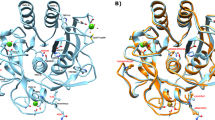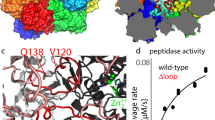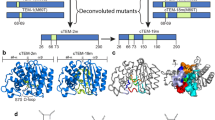Abstract
During the evolution of proteins the pressure to optimize biological activity is moderated by a need for efficient folding. For most proteins, this is accomplished through spontaneous folding to a thermodynamically stable and active native state. However, in the extracellular bacterial α-lytic protease (αLP) these two processes have become decoupled. The native state of αLP is thermodynamically unstable, and when denatured, requires millennia (t1/2 ∼ 1,800 years)1 to refold. Folding is made possible by an attached folding catalyst, the pro-region, which is degraded on completion of folding, leaving αLP trapped in its native state by a large kinetic unfolding barrier (t1/2 ∼1.2 years)1. αLP faces two very different folding landscapes: one in the presence of the pro-region controlling folding, and one in its absence restricting unfolding. Here we demonstrate that this separation of folding and unfolding pathways has removed constraints placed on the folding of thermodynamically stable proteins, and allowed the evolution of a native state having markedly reduced dynamic fluctuations. This, in turn, has led to a significant extension of the functional lifetime of αLP by the optimal suppression of proteolytic sensitivity.
This is a preview of subscription content, access via your institution
Access options
Subscribe to this journal
Receive 51 print issues and online access
$199.00 per year
only $3.90 per issue
Buy this article
- Purchase on Springer Link
- Instant access to full article PDF
Prices may be subject to local taxes which are calculated during checkout




Similar content being viewed by others
References
Sohl, J. L., Jaswal, S. S. & Agard, D. A. Unfolded conformations of α-lytic protease are more stable than its native state. Nature 395, 817–819 (1998).
Baker, D., Shiau, A. K. & Agard, D. A. The role of pro regions in protein folding. Curr. Opin. Cell Biol. 5, 966–970 (1993).
Perona, J. J. & Craik, C. S. Structural basis of substrate specificity in the serine proteases. Protein Sci. 4, 337–360 (1995).
Fontana, A., Polverino de Laureto, P., De Filippis, V., Scaramella, E. & Zambonin, M. Probing the partly folded states of proteins by limited proteolysis. Fold Des. 2, R17–R26 (1997).
Chamberlain, A. K. & Marqusee, S. Touring the landscapes: partially folded proteins examined by hydrogen exchange. Structure 5, 859–863 (1997).
Englander, S. W., Sosnick, T. R., Englander, J. J. & Mayne, L. Mechanisms and uses of hydrogen exchange. Curr. Opin. Struct. Biol. 6, 18–23 (1996).
Rupley, J. A. Susceptibility to attack by proteolytic enzymes. Methods Enzymol. 11, 905–917 (1967).
Wang, L. & Kallenbach, N. R. Proteolysis as a measure of the free energy difference between cytochrome c and its derivatives. Protein Sci. 7, 2460–2464 (1998).
Li, R. & Woodward, C. The hydrogen exchange core and protein folding. Protein Sci. 8, 1571–1590 (1999).
Huyghues-Despointes, B. M., Scholtz, J. M. & Pace, C. N. Protein conformational stabilities can be determined from hydrogen exchange rates. Nature Struct. Biol. 6, 910–912 (1999).
Santoro, M. M. & Bolen, D. W. Unfolding free energy changes determined by the linear extrapolation method. 1. Unfolding of phenylmethanesulfonyl α-chymotrypsin using different denaturants. Biochemistry 27, 8063–8068 (1988).
Wang, E. C., Hung, S. H., Cahoon, M. & Hedstrom, L. The role of the Cys191-Cys220 disulfide bond in trypsin: new targets for engineering substrate specificity. Protein Eng. 10, 405–411 (1997).
Lee, C., Park, S. H., Lee, M. Y. & Yu, M. H. Regulation of protein function by native metastability. Proc. Natl Acad. Sci. USA 97, 7727–7731 (2000).
Huber, R. & Carrell, R. W. Implications of the three-dimensional structure of alpha 1-antitrypsin for structure and function of serpins. Biochemistry 28, 8951–8966 (1989).
Carr, C. M. & Kim, P. S. A spring-loaded mechanism for the conformational change of influenza hemagglutinin. Cell 73, 823–832 (1993).
Bullough, P. A., Hughson, F. M., Skehel, J. J. & Wiley, D. C. Structure of influenza haemagglutinin at the pH of membrane fusion. Nature 371, 37–43 (1994).
Chan, D. C., Fass, D., Berger, J. M. & Kim, P. S. Core structure of gp41 from the HIV envelope glycoprotein. Cell 89, 263–273 (1997).
Orosz, A., Wisniewski, J. & Wu, C. Regulation of Drosophila heat shock factor trimerization: global sequence requirements and independence of nuclear localization. Mol. Cell. Biol. 16, 7018–7030 (1996).
Kelly, J. W. Alternative conformations of amyloidogenic proteins govern their behavior. Curr. Opin. Struct. Biol. 6, 11–17 (1996).
Mace, J. E. & Agard, D. A. Kinetic and structural characterization of muations of glycine 216 in α-Lytic protease: a new target for engineering substrate specificity. J. Mol. Biol. 254, 720–736 (1995).
Halfon, S. & Craik, C. S. Regulation of proteolytic activity by engineered tridentate metal binding loops. J. Am. Chem. Soc. 118, 1227–1228 (1996).
Bai, Y., Milne, J. S., Mayne, L. & Englander, S. W. Primary structure effects on peptide group hydrogen exchange. Proteins 17, 75–86 (1993).
Bolen, D. W. & Santoro, M. M. Unfolding free energy changes determined by the linear extrapolation method. 2. Incorporation of delta G degrees N-U values in a thermodynamic cycle. Biochemistry 27, 8069–8074 (1988).
Midas. The MIDAS display system. J. Mol. Graph. 6, 13–27 (1988).
Acknowledgements
We thank Y. Shibata for assistance with hydrogen exchange experiments, and J. Harris, T. Baird and C. Craik for assistance with trypsin purification. S.S.J. was supported by a Howard Hughes Medical Institute predoctoral fellowship. Research funding was provided by Howard Hughes Medical Institute.
Author information
Authors and Affiliations
Ethics declarations
Competing interests
The authors declare no competing financial interests.
Supplementary information
Rights and permissions
About this article
Cite this article
Jaswal, S., Sohl, J., Davis, J. et al. Energetic landscape of α-lytic protease optimizes longevity through kinetic stability. Nature 415, 343–346 (2002). https://doi.org/10.1038/415343a
Received:
Accepted:
Issue Date:
DOI: https://doi.org/10.1038/415343a
This article is cited by
-
In-cell kinetic stability is an essential trait in metallo-β-lactamase evolution
Nature Chemical Biology (2023)
-
Assembly of a patchy protein into variable 2D lattices via tunable multiscale interactions
Nature Communications (2020)
-
Characterization of Sphingomonas sp. JB13 exo-inulinase: a novel detergent-, salt-, and protease-tolerant exo-inulinase
Extremophiles (2015)
-
Purification and properties of a SDS-resistant xylanase from halophilic Streptomonospora sp. YIM 90494
Cellulose (2013)
-
A novel xylanase with tolerance to ethanol, salt, protease, SDS, heat, and alkali from actinomycete Lechevalieria sp. HJ3
Journal of Industrial Microbiology and Biotechnology (2012)
Comments
By submitting a comment you agree to abide by our Terms and Community Guidelines. If you find something abusive or that does not comply with our terms or guidelines please flag it as inappropriate.



